2017 FORD POLICE INTERCEPTOR SEDAN brakes
[x] Cancel search: brakesPage 141 of 358

TOWING A TRAILER
WARNINGS
Towing trailers beyond the
maximum recommended
gross trailer weight exceeds the
limit of your vehicle and could
result in engine damage,
transmission damage, structural
damage, loss of vehicle control,
vehicle rollover and personal
injury. Do not exceed the GVWR or
the GAWR specified on the
certification label. Note:
See Recommended
Towing Weights (page 139).
Your vehicle may have electrical
items, such as fuses or relays,
related to towing. See
Fuses
(page 158).
Your vehicle's load capacity
designation is by weight, not by
volume, so you cannot necessarily
use all available space when
loading a vehicle or trailer.
Towing a trailer places an extra
load on your vehicle's engine,
transmission, axle, brakes, tires
and suspension. Inspect these
components periodically during,
and after, any towing operation. Load Placement
To help minimize how trailer
movement affects your vehicle
when driving:
•
Load the heaviest items closest
to the trailer floor.
• Load the heaviest items
centered between the left and
right side trailer tires.
• Load the heaviest items above
the trailer axles or just slightly
forward toward the trailer
tongue. Do not allow the final
trailer tongue weight to go
above or below 10-15% of the
loaded trailer weight.
• Select a ball mount with the
correct rise or drop and load
capacity. When both the
loaded vehicle and trailer are
connected, the trailer frame
should be level, or slightly
angled down toward your
vehicle, when viewed from the
side.
When driving with a trailer or
payload, a slight takeoff vibration
or shudder may be present due to
the increased payload weight.
Additional information regarding
proper trailer loading and setting
your vehicle up for towing is
located in another chapter of this
manual. See
Load Limit (page
132).
You can also find information in
the
RV & Trailer Towing Guide
available at your authorized
dealer, or online.
138
Taurus (CPH) Police, Canada/United States of America, enUSA, First Printing Towing
Page 142 of 358
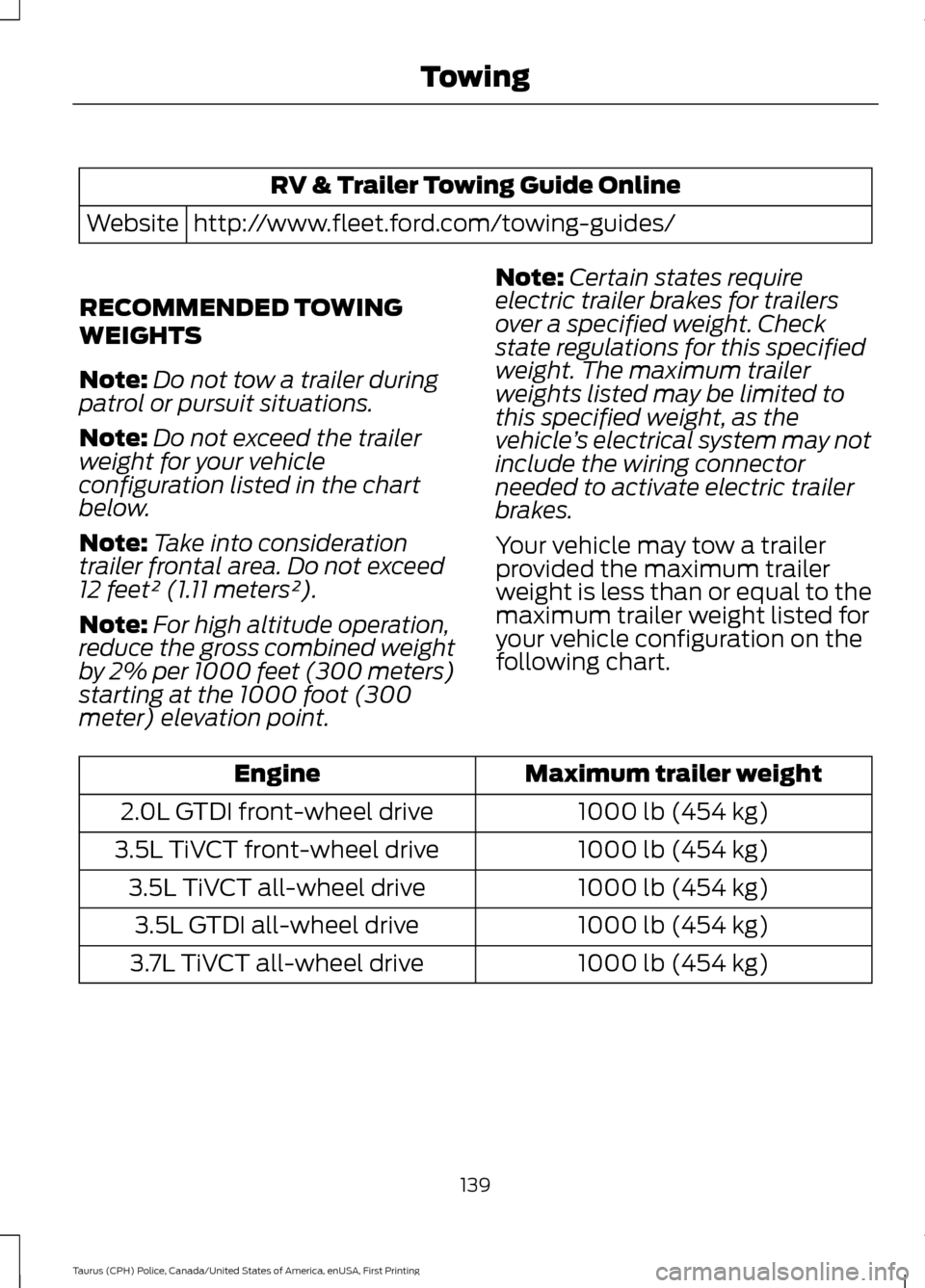
RV & Trailer Towing Guide Online
http://www.fleet.ford.com/towing-guides/
Website
RECOMMENDED TOWING
WEIGHTS
Note: Do not tow a trailer during
patrol or pursuit situations.
Note: Do not exceed the trailer
weight for your vehicle
configuration listed in the chart
below.
Note: Take into consideration
trailer frontal area. Do not exceed
12 feet² (1.11 meters²).
Note: For high altitude operation,
reduce the gross combined weight
by 2% per 1000 feet (300 meters)
starting at the 1000 foot (300
meter) elevation point. Note:
Certain states require
electric trailer brakes for trailers
over a specified weight. Check
state regulations for this specified
weight. The maximum trailer
weights listed may be limited to
this specified weight, as the
vehicle ’s electrical system may not
include the wiring connector
needed to activate electric trailer
brakes.
Your vehicle may tow a trailer
provided the maximum trailer
weight is less than or equal to the
maximum trailer weight listed for
your vehicle configuration on the
following chart. Maximum trailer weight
Engine
1000 lb (454 kg)
2.0L GTDI front-wheel drive
1000 lb (454 kg)
3.5L TiVCT front-wheel drive
1000 lb (454 kg)
3.5L TiVCT all-wheel drive
1000 lb (454 kg)
3.5L GTDI all-wheel drive
1000 lb (454 kg)
3.7L TiVCT all-wheel drive
139
Taurus (CPH) Police, Canada/United States of America, enUSA, First Printing Towing
Page 143 of 358
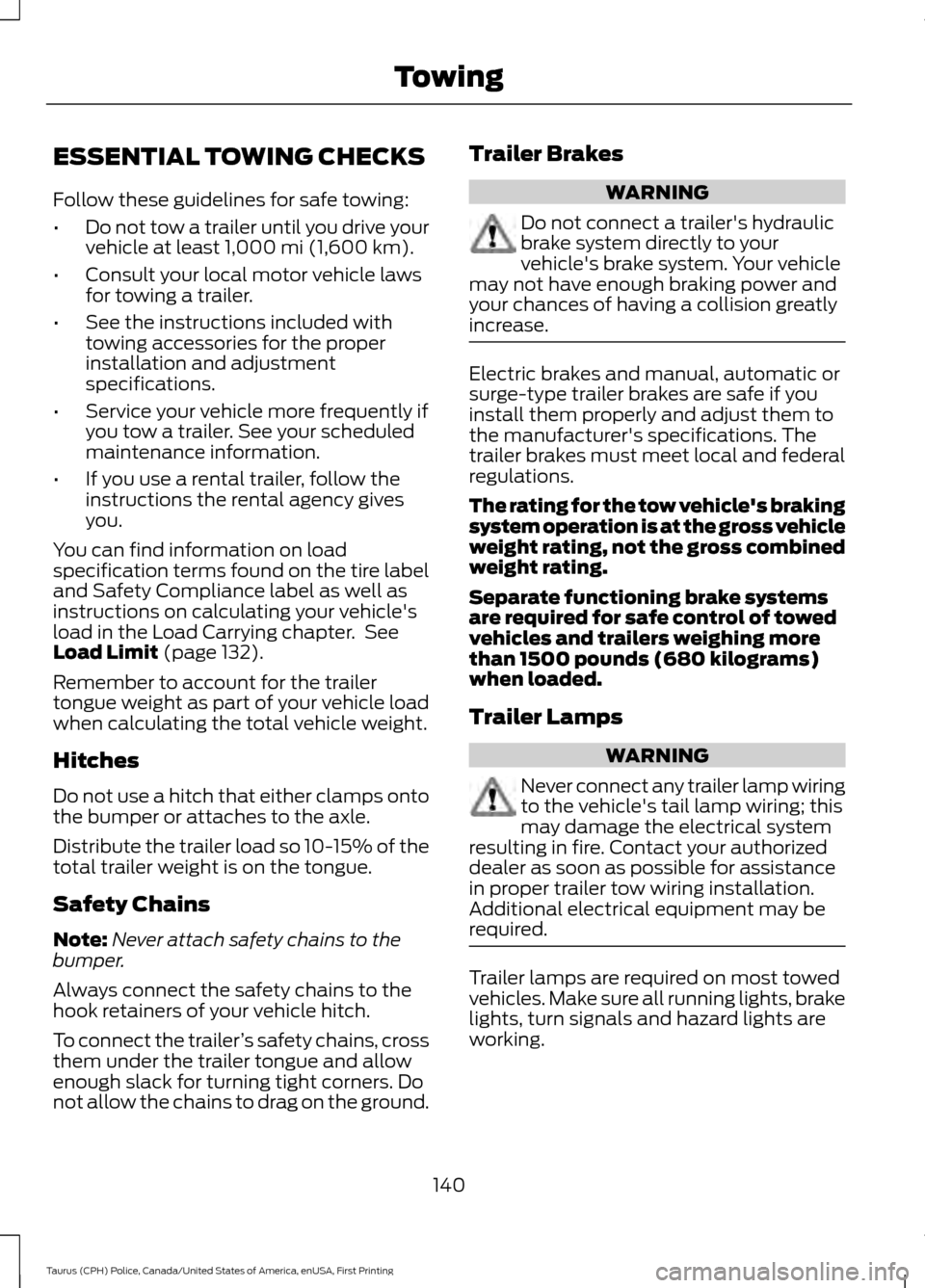
ESSENTIAL TOWING CHECKS
Follow these guidelines for safe towing:
•
Do not tow a trailer until you drive your
vehicle at least 1,000 mi (1,600 km).
• Consult your local motor vehicle laws
for towing a trailer.
• See the instructions included with
towing accessories for the proper
installation and adjustment
specifications.
• Service your vehicle more frequently if
you tow a trailer. See your scheduled
maintenance information.
• If you use a rental trailer, follow the
instructions the rental agency gives
you.
You can find information on load
specification terms found on the tire label
and Safety Compliance label as well as
instructions on calculating your vehicle's
load in the Load Carrying chapter. See
Load Limit
(page 132).
Remember to account for the trailer
tongue weight as part of your vehicle load
when calculating the total vehicle weight.
Hitches
Do not use a hitch that either clamps onto
the bumper or attaches to the axle.
Distribute the trailer load so 10-15% of the
total trailer weight is on the tongue.
Safety Chains
Note: Never attach safety chains to the
bumper.
Always connect the safety chains to the
hook retainers of your vehicle hitch.
To connect the trailer ’s safety chains, cross
them under the trailer tongue and allow
enough slack for turning tight corners. Do
not allow the chains to drag on the ground. Trailer Brakes WARNING
Do not connect a trailer's hydraulic
brake system directly to your
vehicle's brake system. Your vehicle
may not have enough braking power and
your chances of having a collision greatly
increase. Electric brakes and manual, automatic or
surge-type trailer brakes are safe if you
install them properly and adjust them to
the manufacturer's specifications. The
trailer brakes must meet local and federal
regulations.
The rating for the tow vehicle's braking
system operation is at the gross vehicle
weight rating, not the gross combined
weight rating.
Separate functioning brake systems
are required for safe control of towed
vehicles and trailers weighing more
than 1500 pounds (680 kilograms)
when loaded.
Trailer Lamps
WARNING
Never connect any trailer lamp wiring
to the vehicle's tail lamp wiring; this
may damage the electrical system
resulting in fire. Contact your authorized
dealer as soon as possible for assistance
in proper trailer tow wiring installation.
Additional electrical equipment may be
required. Trailer lamps are required on most towed
vehicles. Make sure all running lights, brake
lights, turn signals and hazard lights are
working.
140
Taurus (CPH) Police, Canada/United States of America, enUSA, First Printing Towing
Page 144 of 358
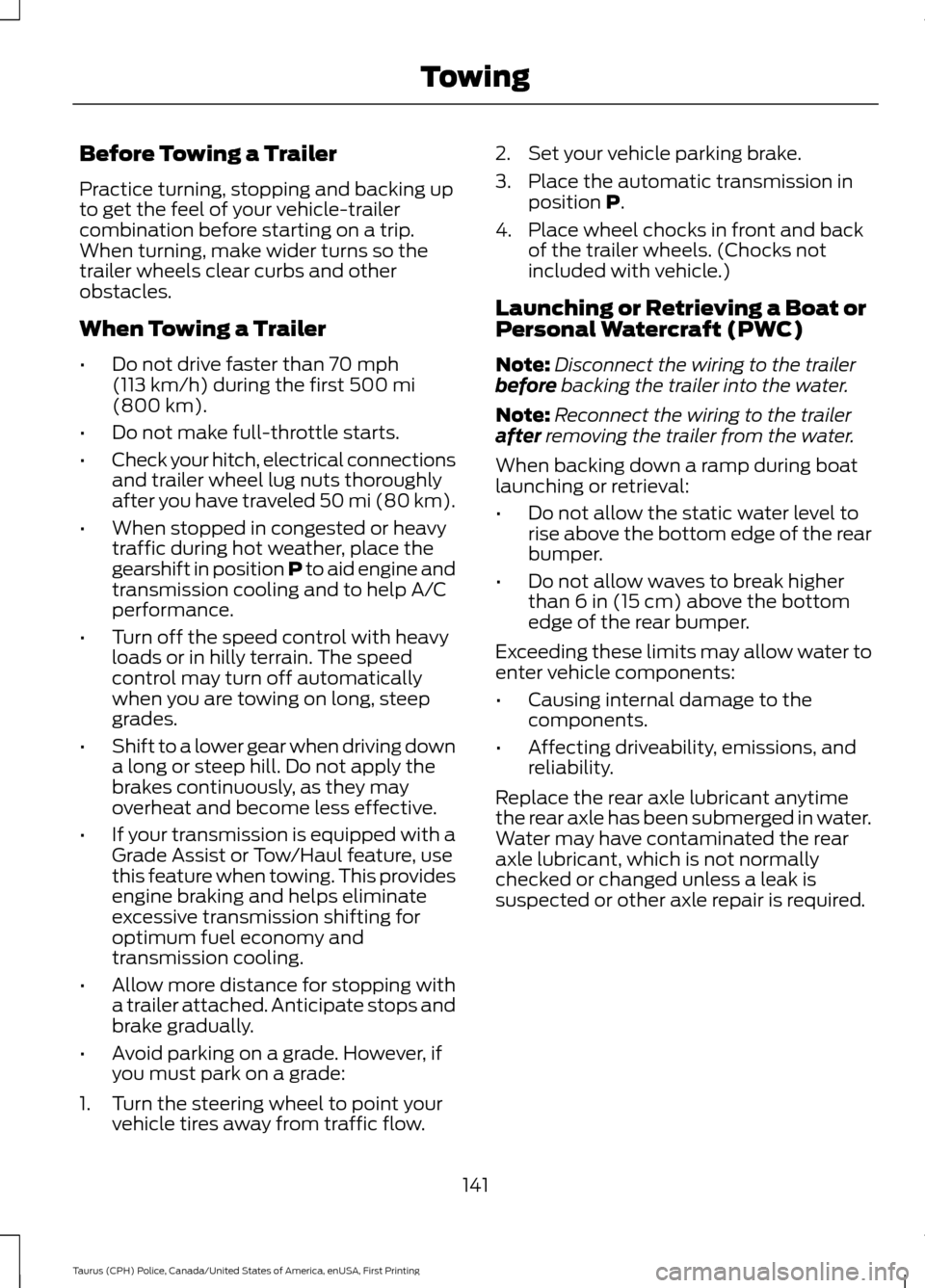
Before Towing a Trailer
Practice turning, stopping and backing up
to get the feel of your vehicle-trailer
combination before starting on a trip.
When turning, make wider turns so the
trailer wheels clear curbs and other
obstacles.
When Towing a Trailer
•
Do not drive faster than 70 mph
(113 km/h) during the first 500 mi
(800 km).
• Do not make full-throttle starts.
• Check your hitch, electrical connections
and trailer wheel lug nuts thoroughly
after you have traveled 50 mi (80 km).
• When stopped in congested or heavy
traffic during hot weather, place the
gearshift in position P to aid engine and
transmission cooling and to help A/C
performance.
• Turn off the speed control with heavy
loads or in hilly terrain. The speed
control may turn off automatically
when you are towing on long, steep
grades.
• Shift to a lower gear when driving down
a long or steep hill. Do not apply the
brakes continuously, as they may
overheat and become less effective.
• If your transmission is equipped with a
Grade Assist or Tow/Haul feature, use
this feature when towing. This provides
engine braking and helps eliminate
excessive transmission shifting for
optimum fuel economy and
transmission cooling.
• Allow more distance for stopping with
a trailer attached. Anticipate stops and
brake gradually.
• Avoid parking on a grade. However, if
you must park on a grade:
1. Turn the steering wheel to point your vehicle tires away from traffic flow. 2. Set your vehicle parking brake.
3. Place the automatic transmission in
position
P.
4. Place wheel chocks in front and back of the trailer wheels. (Chocks not
included with vehicle.)
Launching or Retrieving a Boat or
Personal Watercraft (PWC)
Note: Disconnect the wiring to the trailer
before
backing the trailer into the water.
Note: Reconnect the wiring to the trailer
after
removing the trailer from the water.
When backing down a ramp during boat
launching or retrieval:
• Do not allow the static water level to
rise above the bottom edge of the rear
bumper.
• Do not allow waves to break higher
than
6 in (15 cm) above the bottom
edge of the rear bumper.
Exceeding these limits may allow water to
enter vehicle components:
• Causing internal damage to the
components.
• Affecting driveability, emissions, and
reliability.
Replace the rear axle lubricant anytime
the rear axle has been submerged in water.
Water may have contaminated the rear
axle lubricant, which is not normally
checked or changed unless a leak is
suspected or other axle repair is required.
141
Taurus (CPH) Police, Canada/United States of America, enUSA, First Printing Towing
Page 147 of 358

•
Transmissions give their best fuel
economy when operated in the top
cruise gear and with steady pressure
on the gas pedal.
• Four-wheel-drive operation (if
equipped) is less fuel efficient than
two-wheel-drive operation.
• Close the windows for high-speed
driving.
DRIVING THROUGH WATER WARNING
Do not drive through flowing or deep
water as you may lose control of your
vehicle.
Note:
Driving through standing water can
cause vehicle damage.
Note: Engine damage can occur if water
enters the air filter.
Before driving through standing water,
check the depth. Never drive through water
that is higher than the bottom of the front
rocker area of your vehicle. When driving through standing water, drive
very slowly and do not stop your vehicle.
Your brake performance and traction may
be limited. After driving through water and
as soon as it is safe to do so: •
Lightly press the brake pedal to dry the
brakes and to check that they work.
• Check that the horn works.
• Check that the exterior lights work.
• Turn the steering wheel to check that
the steering power assist works.
FLOOR MATS WARNINGS
Always use floor mats that are
designed to fit the foot well of your
vehicle. Only use floor mats that
leave the pedal area unobstructed. Only
use floor mats that are firmly secured to
retention posts so that they cannot slip out
of position and interfere with the pedals
or impair safe operation of your vehicle in
other ways. Pedals that cannot move freely can
cause loss of vehicle control and
increase the risk of serious personal
injury. Always make sure that the floor
mats are properly attached to the
retention posts in the carpet that are
supplied with your vehicle. Floor mats must
be properly secured to both retention posts
to make sure mats do not shift out of
position. Never place floor mats or any other
covering in the vehicle foot well that
cannot be properly secured to
prevent them from moving and interfering
with the pedals or the ability to control the
vehicle. Never place floor mats or any other
covering on top of already installed
floor mats. Floor mats should always
rest on top of vehicle carpeting surface and
not another floor mat or other covering.
Additional floor mats or any other covering
will reduce the pedal clearance and
potentially interfere with pedal operation.
144
Taurus (CPH) Police, Canada/United States of America, enUSA, First Printing Driving HintsE176360
Page 202 of 358
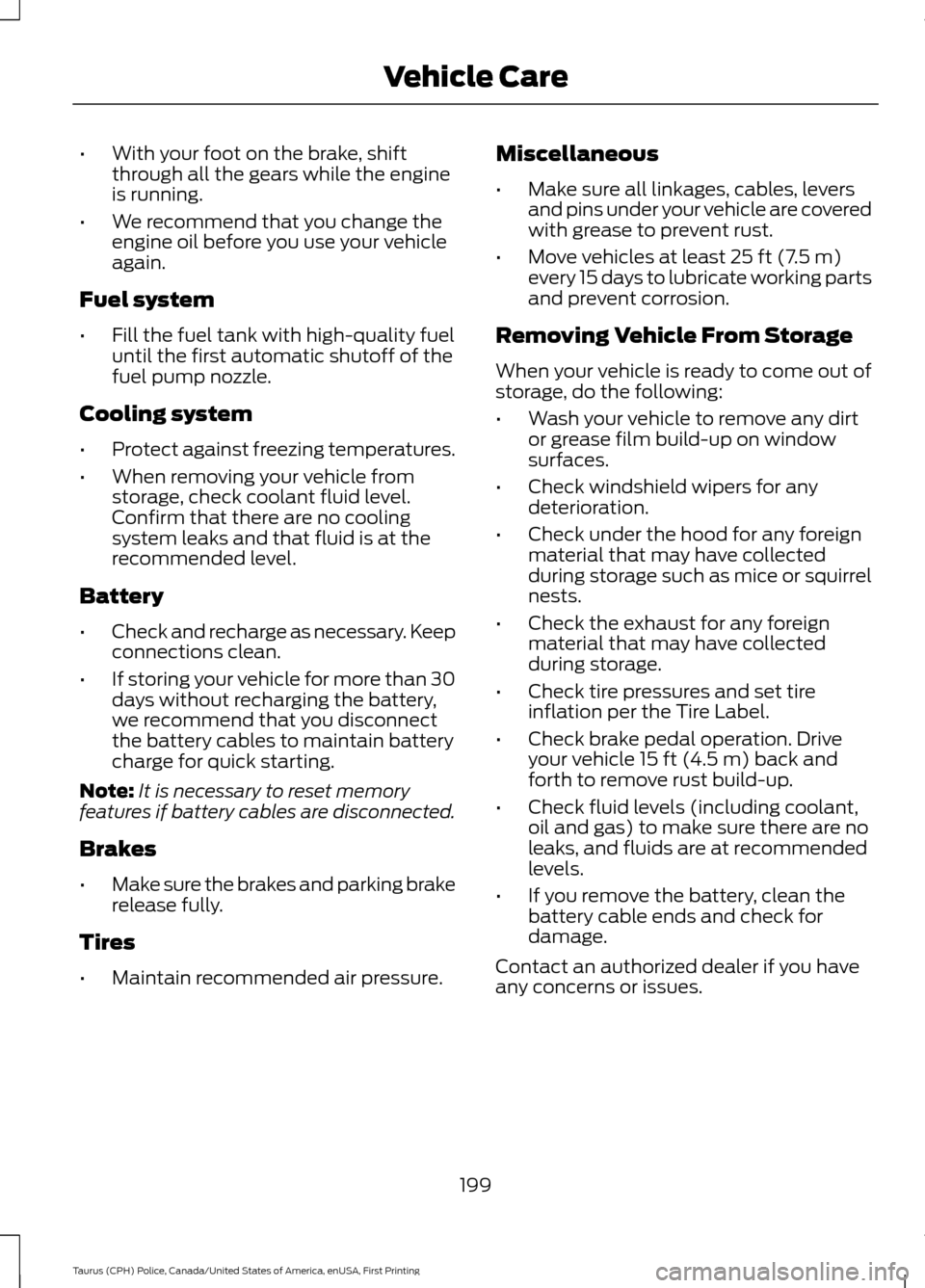
•
With your foot on the brake, shift
through all the gears while the engine
is running.
• We recommend that you change the
engine oil before you use your vehicle
again.
Fuel system
• Fill the fuel tank with high-quality fuel
until the first automatic shutoff of the
fuel pump nozzle.
Cooling system
• Protect against freezing temperatures.
• When removing your vehicle from
storage, check coolant fluid level.
Confirm that there are no cooling
system leaks and that fluid is at the
recommended level.
Battery
• Check and recharge as necessary. Keep
connections clean.
• If storing your vehicle for more than 30
days without recharging the battery,
we recommend that you disconnect
the battery cables to maintain battery
charge for quick starting.
Note: It is necessary to reset memory
features if battery cables are disconnected.
Brakes
• Make sure the brakes and parking brake
release fully.
Tires
• Maintain recommended air pressure. Miscellaneous
•
Make sure all linkages, cables, levers
and pins under your vehicle are covered
with grease to prevent rust.
• Move vehicles at least 25 ft (7.5 m)
every 15 days to lubricate working parts
and prevent corrosion.
Removing Vehicle From Storage
When your vehicle is ready to come out of
storage, do the following:
• Wash your vehicle to remove any dirt
or grease film build-up on window
surfaces.
• Check windshield wipers for any
deterioration.
• Check under the hood for any foreign
material that may have collected
during storage such as mice or squirrel
nests.
• Check the exhaust for any foreign
material that may have collected
during storage.
• Check tire pressures and set tire
inflation per the Tire Label.
• Check brake pedal operation. Drive
your vehicle
15 ft (4.5 m) back and
forth to remove rust build-up.
• Check fluid levels (including coolant,
oil and gas) to make sure there are no
leaks, and fluids are at recommended
levels.
• If you remove the battery, clean the
battery cable ends and check for
damage.
Contact an authorized dealer if you have
any concerns or issues.
199
Taurus (CPH) Police, Canada/United States of America, enUSA, First Printing Vehicle Care
Page 350 of 358
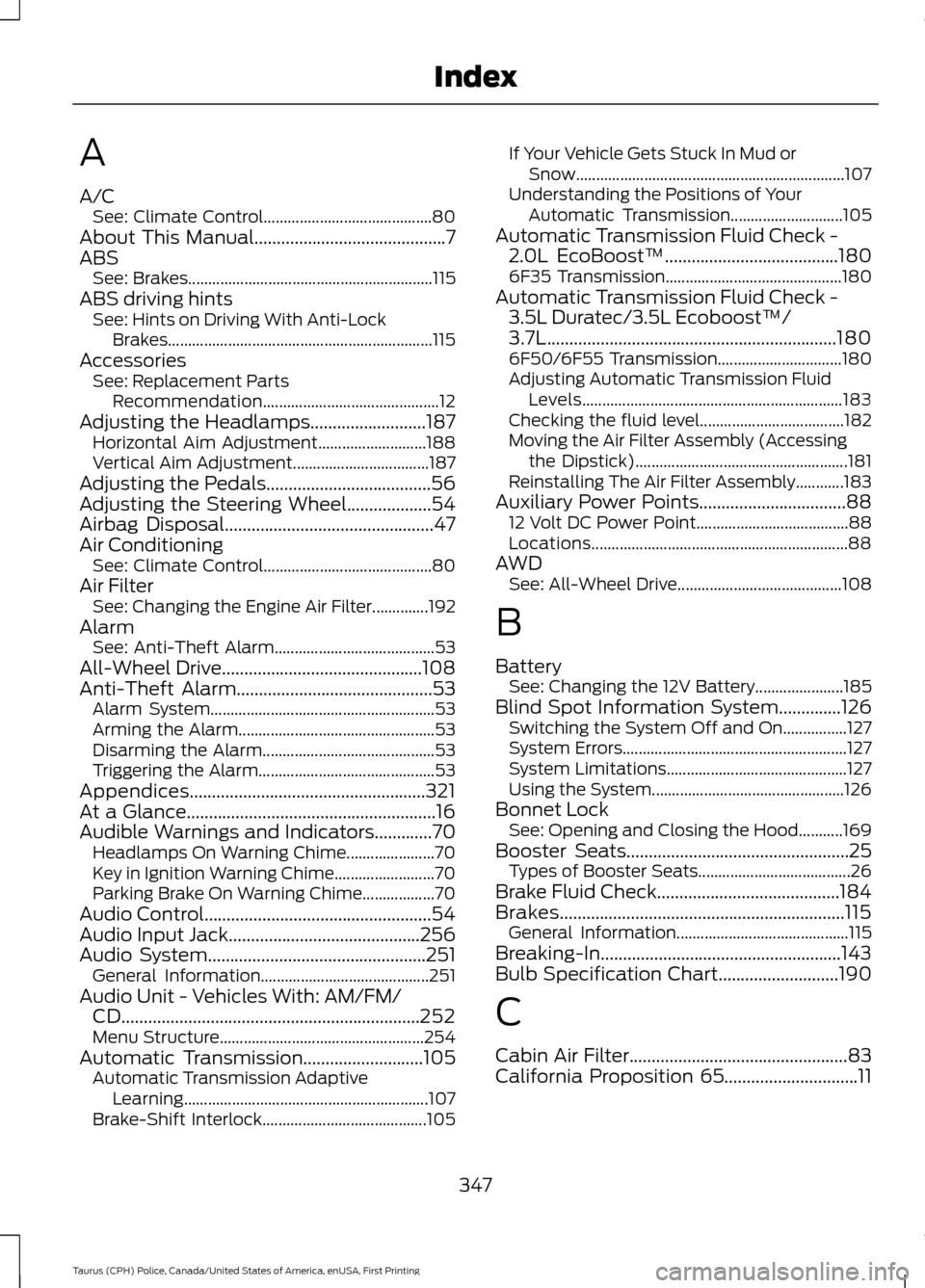
A
A/C
See: Climate Control.......................................... 80
About This Manual...........................................7
ABS See: Brakes............................................................. 115
ABS driving hints See: Hints on Driving With Anti-Lock
Brakes.................................................................. 115
Accessories See: Replacement Parts
Recommendation............................................ 12
Adjusting the Headlamps..........................187 Horizontal Aim Adjustment........................... 188
Vertical Aim Adjustment.................................. 187
Adjusting the Pedals.....................................56
Adjusting the Steering Wheel
...................54
Airbag Disposal...............................................47
Air Conditioning See: Climate Control.......................................... 80
Air Filter See: Changing the Engine Air Filter..............192
Alarm See: Anti-Theft Alarm........................................ 53
All-Wheel Drive
.............................................108
Anti-Theft Alarm............................................53 Alarm System........................................................ 53
Arming the Alarm................................................. 53
Disarming the Alarm........................................... 53
Triggering the Alarm............................................ 53
Appendices.....................................................321
At a Glance........................................................16
Audible Warnings and Indicators
.............70
Headlamps On Warning Chime...................... 70
Key in Ignition Warning Chime......................... 70
Parking Brake On Warning Chime.................. 70
Audio Control
...................................................54
Audio Input Jack...........................................256
Audio System.................................................251 General Information.......................................... 251
Audio Unit - Vehicles With: AM/FM/ CD...................................................................252
Menu Structure................................................... 254
Automatic Transmission...........................105 Automatic Transmission Adaptive
Learning............................................................. 107
Brake-Shift Interlock......................................... 105If Your Vehicle Gets Stuck In Mud or
Snow................................................................... 107
Understanding the Positions of Your Automatic Transmission............................ 105
Automatic Transmission Fluid Check - 2.0L EcoBoost™.......................................180
6F35 Transmission............................................ 180
Automatic Transmission Fluid Check - 3.5L Duratec/3.5L Ecoboost™/
3.7L
.................................................................180
6F50/6F55 Transmission............................... 180
Adjusting Automatic Transmission Fluid Levels................................................................. 183
Checking the fluid level.................................... 182
Moving the Air Filter Assembly (Accessing the Dipstick)..................................................... 181
Reinstalling The Air Filter Assembly............183
Auxiliary Power Points.................................88 12 Volt DC Power Point...................................... 88
Locations................................................................ 88
AWD See: All-Wheel Drive......................................... 108
B
Battery See: Changing the 12V Battery...................... 185
Blind Spot Information System..............126 Switching the System Off and On................127
System Errors........................................................ 127
System Limitations............................................. 127
Using the System................................................ 126
Bonnet Lock See: Opening and Closing the Hood...........169
Booster Seats..................................................25 Types of Booster Seats...................................... 26
Brake Fluid Check.........................................184
Brakes................................................................115 General Information........................................... 115
Breaking-In......................................................143
Bulb Specification Chart...........................190
C
Cabin Air Filter
.................................................83
California Proposition 65..............................11
347
Taurus (CPH) Police, Canada/United States of America, enUSA, First Printing Index
Page 352 of 358

Proper Driver and Front Passenger Seating
Adjustment........................................................ 37
Driving Aids.....................................................126
Driving Hints...................................................143
Driving Through Water................................144
DRL See: Daytime Running Lamps......................... 59
E
Economical Driving......................................143
Emission Control System..........................102 On-Board Diagnostics (OBD-II)................... 103
Readiness for Inspection and Maintenance (I/M) Testing................................................... 103
End User License Agreement...................321 VEHICLE SOFTWARE END USER LICENSE
AGREEMENT (EULA) .................................. 321
Engine Block Heater
......................................92
Using the Engine Block Heater........................ 93
Engine Coolant Check.................................176 Adding Coolant..................................................... 177
Coolant Change................................................... 178
Engine Coolant Temperature Management................................................... 179
Fail-Safe Cooling................................................ 178
Recycled Coolant................................................ 178
Severe Climates.................................................. 178
Engine Oil Check...........................................174 Adding Engine Oil................................................ 175
Engine Oil Dipstick - 2.0L EcoBoost™..................................................174
Engine Oil Dipstick - 3.5L Duratec/3.5L Ecoboost™/3.7L.........................................174
Engine Specifications - 2.0L EcoBoost™.................................................224
Drivebelt Routing............................................... 224
Engine Specifications - 3.5L Duratec.........................................................224
Drivebelt Routing............................................... 225
Engine Specifications - 3.5L Ecoboost™.................................................225
Drivebelt Routing............................................... 225
Engine Specifications - 3.7L
.....................226
Drivebelt Routing............................................... 226
Environment
......................................................15
Essential Towing Checks...........................140 Before Towing a Trailer...................................... 141Hitches...................................................................
140
Launching or Retrieving a Boat or Personal Watercraft (PWC).......................................... 141
Safety Chains....................................................... 140
Trailer Brakes....................................................... 140
Trailer Lamps....................................................... 140
When Towing a Trailer....................................... 141
Event Data Recording See: Data Recording.............................................. 9
Export Unique Options.................................14
Exterior Mirrors
................................................63
Blind Spot Information System...................... 64
Fold-Away Exterior Mirrors............................... 63
Heated Exterior Mirrors ..................................... 63
Integrated Blind Spot Mirror............................. 63
Power Exterior Mirrors........................................ 63
F
Fastening the Seatbelts..............................30 Seatbelt Locking Modes..................................... 31
Using Seatbelts During Pregnancy...............30
Floor Mats
.......................................................144
Foot Pedals See: Adjusting the Pedals................................. 56
Ford Credit
..........................................................11
US Only...................................................................... 11
Ford Protect
..................................................299
Ford Protect Extended Service Plan
(CANADA ONLY).......................................... 300
Ford Protect Extended Service Plans (U.S. Only).................................................................. 299
Front Passenger Sensing System
............38
Fuel and Refueling.........................................95
Fuel Consumption........................................101
Calculating Fuel Economy............................... 101
Filling the Fuel Tank............................................ 101
Fuel Filler Funnel Location..........................97
Fuel Filter
.........................................................185
Fuel Quality - E85..........................................96 Choosing the Right Fuel - Flex Fuel
Vehicles.............................................................. 96
Switching Between E85 and Gasoline.........97
Fuel Quality - Gasoline.................................97 Choosing the Right Fuel..................................... 97
Fuel Shutoff
....................................................147
Fuses.................................................................158
349
Taurus (CPH) Police, Canada/United States of America, enUSA, First Printing Index